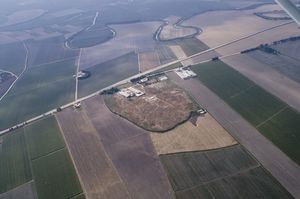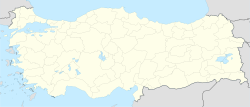تل طعينات
موقع تل طعينات الأثري في سهل العمق، على ثنية نهر العاصي القديم، على بعد 25 كم شرق أنطاكية في لواء الإسكندرونة (محافظة هاتاي)، قريب جداً من الحدود السورية-التركية. ويعود للحقبة السورية الحيثية (سور-حيثية) التي ازدهرت في الفترة بين 1180 ق.م و700 ق.م. ويقع الموقع على بعد 800 متر من تل عطشانة، موقع مدينة ألالاخ القديمة. وهو الموقع المحتمل لمدينة كالنه المذكورة في التوراة.
Tell Ta'yinat | |
 تل طعينات | |
| المكان | محافظة هاتاي، تركيا |
|---|---|
| المنطقة | المشرق |
| الإحداثيات | 36°14′51″N 36°22′35″E / 36.24750°N 36.37639°E |
| النوع | مستوطنة |
| ملاحظات حول الموقع | |
| الحالة | In ruins |
. . . . . . . . . . . . . . . . . . . . . . . . . . . . . . . . . . . . . . . . . . . . . . . . . . . . . . . . . . . . . . . . . . . . . . . . . . . . . . . . . . . . . . . . . . . . . . . . . . . . . . . . . . . . . . . . . . . . . . . . . . . . . . . . . . . . . . . . . . . . . . . . . . . . . . . . . . . . . . . . . . . . . . . .
التاريخ
The site was a major urban centre in two separate phases, during the Early Bronze Age and Early Iron Age.
The red-black burnished ware (Karaz ware) is recovered in large quantities from the Early Bronze Age (EBA) II and IIIa levels. It is among the most commonly used pottery on the site.[1] This type of pottery diminishes through the end of the last phase of EBA.[2] This pottery is believed to be influenced by the Kura-Araxes culture, arriving into this area around 3000 BCE.[3]
During the Early Iron Age, this is thought likely to be the site of ancient Kinalua, the capital of one of the Neo-Hittite/Aramean city-kingdoms of Walistin (Aramaic) or Palistin (neo-Hittite). Among the culturally diverse Syro-Hittite states in the north Syrian river-plain the rulers of Kinalua continued to bear royal Hittite names in the 8th century BCE. At the first Assyrian conquest in the 870s BCE, the victors carried away from Kinalua silver and gold, 100 talents of tin, essential for making bronze, and 100 talents of iron, 1000 oxen and 10,000 sheep, linen robes and decorated couches and beds of boxwood, as well as "10 female singers, the king's brother's daughter with a rich dowry, a large female monkey and ducks".[4] At a later campaign the Assyrians forced its king Tutammu to submit.
الآثار
- إكتشافات تل طعينات محفوظة في متحف أنطاكية الأثري.
بعثة أثرية أمريكية من المعهد الشرقي في شيكاغو يرأسها عالم الآثار روبرت بريدوود (Robert Braidwood) كانت تتولى التنقيب في موقع تل طعينات من عام ١٩٣٥ لعام ١٩٣٨. وفي عام ٢٠٠٤ لعام ٢٠٠٩ بعثة أثرية كندية من جامعة تورنتو كانت تتولى التنقيب في موقع تل طعينات الأثري.
الهامش
- ^ Braidwood-Braidwood 1960:fig.398-399
- ^ Tell Tayinat - The Archaeological Settlements of Turkey - TAY Project
- ^ Stephen Batiuk, Mitchell Rothman, Early Transcaucasian Cultures and Their Neighbors. University Museum of the University of Pennsylvania: Expedition, 2007
- ^ A.K. Grayson, Assyrian Rulers of the Early First Millennium BC, vol. I: 1991:217f, quoted in Robin Lane Fox, Travelling Heroes in the Epic Age of Homer, 2008:94.
انظر أيضاً
وصلات خارجية
- Tayinat Archaeological Project —the website for the current excavations
- Oriental Institute page on Tell Tayinat
